Drum kit
| The drum kit |

 |
|
| Not shown |
| See also |
A drum kit—also called a drum set, trap set, or simply drums—is a collection of drums and other percussion instruments, typically cymbals, which are set up on stands to be played by a single player[1] with drumsticks held in both hands and the feet operating pedals that control the hi-hat cymbal and the beater for the bass drum. A drum kit consists of a mix of drums (categorized classically as membranophones, Hornbostel-Sachs high-level classification 2) and idiophones most significantly cymbals but also including the woodblock and cowbell (classified as Hornbostel-Sachs high-level classification 1).[2] In the 2000s, some kits also include electronic instruments (Hornbostel-Sachs classification 53) and both hybrid and entirely electronic kits are used.
A standard modern kit (for a right-handed player), as used in popular music and taught in music schools,[3][4] contains:
- A snare drum, mounted on a stand, placed between the player's knees and played with drum sticks (which may include rutes or brushes)
- A bass drum, played by a pedal operated by the right foot, which moves a felt-covered beater
- One or more toms, played with sticks or brushes
- A hi-hat (two cymbals mounted on a stand), played with the sticks, opened and closed with left foot pedal (can also produce sound with the foot alone)
- One or more cymbals, mounted on stands, played with the sticks
All of these are classed as non-pitched percussion, allowing for the music to be scored using percussion notation, for which a loose semi-standardized form exists for the drum kit. If some or all of them are replaced by electronic drums, the scoring and most often positioning remains the same, allowing a standard teaching approach. The drum kit is usually played while seated on a drum stool or throne. The drum kit differs from instruments that can be used to produce pitched melodies or chords, even though drums are often placed musically alongside others that do, such as the piano or guitar.[5] The drum kit is part of the standard rhythm section used in many types of popular and traditional music styles ranging from rock and pop to blues and jazz. Other standard instruments used in the rhythm section include the electric bass, electric guitar and keyboards.
Many drummers extend their kits from this basic pattern, adding more drums, more cymbals, and many other instruments including pitched percussion. In some styles of music particular extensions are normal, for example double bass drums in heavy metal music and the enlarged kits used by some progressive rock drummers, which may include unusual instruments such as gongs. Some performers, such as some rockabilly drummers, use small kits that omit elements from the basic setup. Some drum kit players may have other roles in the band, such as providing backup vocals, or less commonly, lead vocals.
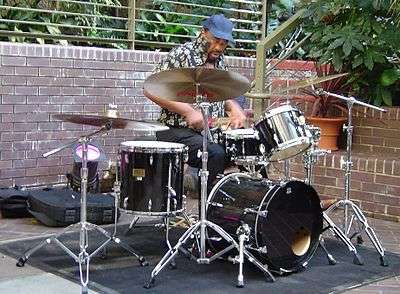
History

Early development
Prior to the development of the drum set, the standard way that drums and cymbals were used in military and orchestral music settings was to have the different drums and cymbals played separately by different percussionists. Thus, in an early 1800s orchestra piece, if the score called for bass drum, triangle and cymbals, three percussionists would be hired to play these three instruments. In the 1840s, percussionists began to experiment with foot pedals as a way to enable them to play more than one instrument. In the 1860s, percussionists started combining multiple drums into a set. The bass drum, snare drum, cymbals, and other percussion instruments were all played using hand-held drum sticks. Drummers in musical theater shows and stage shows, where the budget for pit orchestras were often limited, contributed to the creation of the drum set because they tried to develop ways so that one drummer could do the job of multiple percussionists.
Double-drumming was developed to enable one person to play the bass and snare with sticks, while the cymbals could be played by tapping the foot on a "low-boy". With this approach, the bass drum was usually played on beats one and three (in 4/4 time). While the music was first designed to accompany marching soldiers, this simple and straightforward drumming approach eventually led to the birth of ragtime music when the simplistic marching beats became more syncopated. This resulted in a greater 'swing' and dance feel. The drum set was initially referred to as a "trap set," and from the late 1800s to the 1930s, drummers were referred to as "trap drummers." By the 1870s, drummers were using an "overhang pedal." Most drummers in the 1870s preferred to do double drumming without any pedal to play multiple drums, rather than use an overhang pedal. Companies patented their pedal systems such as Dee Dee Chandler of New Orleans 1904–05.[6] Liberating the hands for the first time, this evolution saw the bass drum played with the foot of a standing percussionist (thus the term "kick drum"). The bass drum became the central piece around which every other percussion instrument would later revolve.
Ludwig-Musser, William F. Ludwig, Sr., and his brother, Theobald Ludwig, founded the Ludwig & Ludwig Co. in 1909 and patented the first workable bass drum pedal system, paving the way for the modern drum kit.[7] It was the golden age of drum building for many famous drum companies, with Ludwig introducing... "The ornately engraved Black Beauty Brass Snare drum; Slingerland premiered its Radio King solid-maple shell; Leedy invented the floating drum head & self-aligning lug;& Gretsch originated the three-way tension system of the Gladstone snare drum".[8] Wire brushes for use with drums and cymbals were introduced in 1912. The need for brushes arose due to the problem of the drum sound overshadowing the other instruments on stage. Drummers began using metal fly swatters to reduce the volume on stage next to the other acoustic instruments. Drummers could still play the rudimentary snare figures and grooves with brushes they would normally play with drumsticks. As brushes gained popularity, the drum companies started manufacturing brushes.
20th century



By World War I, drum kits were often marching band-style military bass drums with many percussion items suspended on and around them. Drum kits became a central part of jazz music, especially Dixieland. The modern drum kit was developed in the Vaudeville era during the 1920s in New Orleans.[9] In 1917, a New Orleans band called "The Original Dixieland Jazz Band " recorded jazz tunes that became hits all over the country. These were the first official jazz recordings. Drummers such as Baby Dodds, "Zutty" Singleton and Ray Baduc had taken the idea of marching rhythms, combining the bass drum and snare drum and "traps", a term used to refer to the percussion instruments associated with immigrant groups, which included miniature cymbals, tom toms, cowbells and woodblocks. They started incorporating these elements with ragtime, which had been popular for a couple of decades, creating an approach which evolved into a jazz drumming style.
Budget constraints and space considerations in musical theatre pit orchestras led bandleaders to pressure fewer percussionists to cover more percussion parts. Metal consoles were developed to hold Chinese tom-toms, with swing-out stands for snare drums and cymbals. On top of the console was a "contraption" tray (shortened to "trap"), used to hold items like whistles, klaxons, and cowbells, so these drums/kits were dubbed "trap kits". Hi-hat stands became available around 1926.[7]
In 1918 Baby Dodds ( Warren "Baby" Dodds, circa 1898–1959), playing on riverboats with Louis Armstrong on the Mississippi, was modifying the military marching set-up and experimenting with playing the drum rims instead of woodblocks, hitting cymbals with sticks (1919), which was not yet common, and adding a side cymbal above the bass drum, what became known as the ride cymbal. Drum maker William Ludwig developed the "sock" or early low-mounted high-hat after observing Dodd's drumming. Ludwig noticed that Dodd tapped his left foot all the time. Dodds had Ludwig raise the newly produced low hats 9 inches higher to make it easier to play, thus creating the modern hi-hat cymbal.[10] Dodds was one of the first drummers to also play the broken-triplet beat that became the standard pulse and roll of modern ride cymbal playing. Dodds also popularized the use of Chinese cymbals.[11]
In 1919, US Congress passed a prohibition law outlawing the manufacturing and transporting of drinking alcohol. When drinking became illegal, it became popular in underground nightclubs. The type of music that was played at these underground establishments that were selling alcohol was jazz. It was not seen as upstanding to listen to or perform jazz music, because it was an African American style and at that time the United States was segregated and racism was a prevalent issue. Because jazz music was seen as great dance music, big band jazz became popular in nightclubs. In the 1920s, freelance drummers emerged. They were hired to play shows, concerts, theaters, clubs and back dancers and artists of various genres. Just as modern drummers have many different roles, so did the drummers of the 1920s. One important role for drummers in the 1920s is what is referred to in modern times as a foley artist. During silent films, an orchestra was hired to accompany the silent film and the drummer was responsible for providing all the sound effects. Drummers played instruments to imitate gun shots, planes flying overhead, a train coming into a train station, and galloping horses etc.
Sheet music from the 1920s provides evidence that the drummer's sets were starting to evolve in size and sound to support the various acts mentioned above. However, the first "talkies" or films with audio, were released circa 1927 and by 1930 most films were released with a soundtrack and the silent film era was over. The downside of the technological breakthrough was that thousands of drummers who served as sound effect specialists were put out of work overnight. A similar panic was felt by drummers in the 1980s, when electronic drum machines were first released.
Big Band drumming
In 1929, when the stock market crash resulted in a global depression, one of the things that helped people cope with the trying years was swing jazz music. By the early to mid 1930's, big band swing was being embraced throughout the US it became the country's most popular form of music. The other contributing factor to the big band's success during the 1930s was the popularity of radio. The drum kit played a key role in the big band swing sound. Throughout the 1930s Chick Webb and Gene Krupa at the Savoy Ballroom in Harlem, increased the visual and musical driving force of the drummer and their equipment by simply being so popular and in demand- and they ensured that their drum kits became not only functionally developed but dazzling and well designed.[12] Jazz drummers were influential in developing the concept of the modern drum kit and extending playing techniques. Gene Krupa was the first drummer to head his own orchestra and thrust the drums into the spotlight with his drum solos. Others would soon follow his lead.
As the music of the world was evolving, so was the drum set. Tom-tom drums, small crash cymbals, Chinese cymbals and hi-hat cymbals were added to the drum set. The hi-hats were the primary way for the drummers of the big band era to keep time. Before 1930, while playing the New Orleans jaz and Chicago styles, drummers would choke the cymbals on the "ands" of eighth note figures as an alternative to playing a buzz roll, the rim of the drums, or on the woodblocks to keep time. This muting method of keeping time by choking the crash and china cymbals proved to be awkward, so the drummers of that time came up with the idea of having a foot-operated cymbal. This resulted in the creation of the snowshoe cymbal, a foot-operated cymbal. It enabled drummers to play the eighth note figures ("Boom, Chick, Boom, Chick, Boom, Chick") between the right and left foot, improving the ergonomics and facility of drumset playing and helping drummers to keep a more steady rhythm.
Toward the end of the 1920s, variations of the hi-hats were introduced. One of the most popular hand held hi-hat cymbal variations used was called the "hand sock cymbals". The reason for the name "hi-hat" was because earlier versions of the hi-hat were referred to as a "low boy." The evolution that became the "hi-hats" allowed drummers to play the two cymbals with drum sticks while simultaneously controlling how open or closed the two cymbals were with their foot. The pedal could also be used to play the cymbals with the foot alone, while the right hand played other drums. By the 1930s, Ben Duncan and others popularized streamlined trap kits leading to a basic four piece drum set standard: bass, snare, tom-tom, and a larger floor tom. In time, legs were fitted to larger floor toms, and "consolettes" were devised to hold smaller tom-toms (ride toms) on the bass drum.
Bebop drumming
In the early 1940s, many jazz musicians, especially African American jazz musicians, started to stray from the popular big band dance music of the 1930s. Their experimentation and quest for deeper expression and freedom on the instrument led to the birth of a new style of music based from Harlem called bebop music. Whereas swing was a popular music designed for dancing, bebop was a "musician's music" designed for listening. During the bebop era, given that bands no longer had to accompany dancers, bandleaders could speed up the tempo. Bebop was also much more based on improvisation, in comparison to the heavily arranged big band scores. Bebop musicians would take an old standard and re-write the melody, add more complex chord changes, resulting in a new composition.
Swing drummers such as Max Roach and Kenny Clarke had already deviated from the large marching band-style bass drums, finding that they were too loud and boomy. Bebop drummers continued this trend, and they started trying out smaller bass drum sizes in the drum set. Bebop drummers' experimentations with new drum sizes and new sounds led to the innovative concept of applying the busy "four on the floor" bass drum rhythms to a new larger cymbal called the ride cymbal. By focusing on keeping time on the new ride cymbal instead of the bass drum, the "feel" went from bass drum and hi-hat heavy, to a lighter melodic feel that has been explained as "floating on top of the time." This allowed drummers to express themselves in a more melodic fashion by playing the rhythms used by the guitar, piano and sax players using the new smaller, more focused bass drums and snare. Louie Bellson also assisted in the innovative sizes and sounds of the 1940s drum set by pioneering the use of two bass drums, or the double bass drum kit.
Rock drumming

With rock and roll coming into place, a watershed moment occurred between 1962 and 1964 when the Surfaris released "Wipe Out", as well as when Ringo Starr of The Beatles played his Ludwig kit on American television. As rock moved from the nightclubs and bars and into stadiums in the 1960s, there was a trend towards bigger drum kits. The trend towards larger drum kits took momentum in the 1970s with the emergence of progressive rock. By the 1980s, widely popular drummers like Billy Cobham, Carl Palmer, Nicko McBrain, Phil Collins, Stewart Copeland, Simon Phillips and Neil Peart were using large numbers of drums and cymbals. In the 1980s, some drummers began to use electronic drums.
In the 2010s, some drummers use a variety of auxiliary percussion instruments, found objects, and electronics as part of their "drum" kits. Popular electronics include: electronic sound modules; laptop computers used to activate loops, sequences and samples; metronomes and tempo meters; recording devices; and personal sound reinforcement equipment (e.g., a small PA system to amplify electronic drums and provide a monitor).
Recording
On early recording media (until 1925[13]) such as wax cylinders and discs carved with an engraving needle, sound balancing meant that musicians had to be literally moved in the room.[13] Drums were often put far from the horn (part of the mechanical transducer) to reduce sound distortion. Since this affected the rendition of cymbals at playback, sound engineers of the time remedied the situation by asking drummers to play the content of the cymbals onto woodblocks, temple blocks, and cowbells for their loudness and short decay.
Components
Terminology
Breakables, shells, extensions, hardware

The drum kit may be loosely divided into four parts:
- Breakables: Sticks, various cymbals, snare drum, throne (stool) and sometimes the bass drum pedal.
- Shells: Bass drum and toms
- Extensions: Cowbell, tambourine, chimes, any other instrument not part of the standard kit
- Hardware: Cymbal stands, drum stands, pedals
There are several reasons for this division. When more than one band plays in a single performance, the drum kit is often considered part of the backline (the key rhythm section equipment that stays on stage all night, which often also includes a bass amp and a stage piano), and which is shared between/among the drummers. Often the main "drawcard" act will provide the drums, as they are being paid more, possibly have the better gear, and in any case have the prerogative of using their own. However sticks, snare drum and cymbals are commonly swapped, each drummer bringing their own, and sometimes other components. The term breakables in this context refers to whatever basic components the "guest" drummer is expected to bring. Similar considerations apply if using a "house kit" (a drum kit owned by the venue, which is rare), even if there is only one band at the performance.
The snare drum and cymbals are the core of the breakables, as they are particularly critical and individual components of the standard kit, in several related ways.
- Their tone varies a great deal from drummer to drummer, reflecting their individual styles and the styles of music they play. As such, even drummers from the same genre of music may prefer a different brand or size of snare.
- The snare drum often does not match the kit, for example being a metal or plain wood shell in a kit where the other drums are in a matching finish.
- Drummers tend to spend more time playing the snare and cymbals than the other drums.
- Thin and/or bell-metal cymbals are easily broken by poor technique.
- Many drummers use thinner heads on their snare than the other drums.
- Often, a drummer will retain their snare drum and cymbals when upgrading the rest of the kit, or upgrade cymbals or snare while keeping the other drums.
Much the same considerations apply to bass drum pedals and the stool, but these are not always considered breakables, particularly if changeover time between bands is very limited. Swapping the snare drum in a standard kit can be done very quickly. Replacing cymbals on stands takes longer, particularly if there are many of them, and cymbals are easily damaged by incorrect mounting, so many drummers prefer to bring their own cymbal stands.
Drum sizes
See Common configurations below for typical drum sizes.
Traditionally, in America and the United Kingdom, drum sizes were expressed as depth x diameter, both in inches, but in The United Kingdom it was stated the other way around. More recently, many drum kit manufacturers have begun to express their sizes in terms of diameter x depth; still in the measure of inches.
Manufacturers using the American traditional format in their catalogs include these:
Those using the European measures of diameter x depth include these:
- Brady Drum Company
- Mapex Drums
- Meinl Percussion[14]
- Pearl Drums
- Premier Percussion
- Rogers Drums
- Sonor
- Yamaha Drums
For example, a hanging tom 12 inches in diameter and 8 inches deep would be described by Tama as 8 inches × 12 inches, but by Pearl as 12 inches × 8 inches, and a standard diameter Ludwig snare drum 5 inches deep is a 5-inch × 14-inch, while the UK's Premier Manufacturer offers the same dimensions as: a 14-inch × 5-inch snare.
Drums
Snare drum

The snare drum is essential as it is the musical center of the kit. It provides the strongest regular accents, played by the left hand (if right handed), and the backbone for many fills. It produces its distinctive sound, due to the bed of snare wires fitted to the underside of the drum which, when engaged, vibrate with the bottom (snare-side) drum skin (head), creating a snappy, buzzing sound.
Toms

Tom-tom drums, or toms for short, are drums without snares and played with sticks (or whatever tools the music style requires), and are the most numerous drums in most kits. They provide the bulk of most drum fills and solos.
They include:
- Traditional double-headed rack toms, of varying depths
- Floor toms
- Single-headed concert toms
- Rototoms
The smallest and largest drums without snares, such as octobans and gong drums, are sometimes considered toms.
The naming of common configurations is largely a reflection of the number of toms, as only the drums are conventionally counted, and these configurations all contain one snare and one or more bass drums, (though not regularly any standardized use of 2 bass/kick drums) the balance usually being in toms.
Bass drum
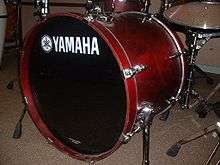
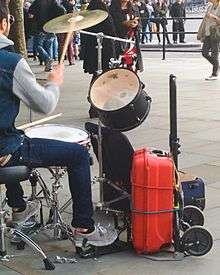
The bass drum (also known as the "kick drum") provides a regular but often-varied foundation to the rhythm. The bass drum is the lowest pitched drum and usually provides the basic beat or timing element with basic pulse patterns. Some drummers may use two or more bass drums or use a double bass drum pedal with a single bass drum. Double bass drumming is an important technique in many heavy metal genres. Using a double bass drum pedal enables a drummer to play a double bass drum style with only one bass drum, saving space in recording/performance areas and reducing time and effort during set-up, taking down, and transportation.
Other drums
Octobans/Rocket toms (Pearl)/Deccabons were designed for use within a drum kit, extending the tom range upwards in pitch, primarily by their depth; as well as diameter (typically 6").

Timbales are tuned much higher than a tom of the same diameter, and normally played with very light, thin, non-tapered sticks. They have relatively thin heads and a very different tone than a tom, but are used by some drummers/percussionists to extend the tom range upwards. Alternatively, they can be fitted with tom heads and tuned as shallow concert toms. Attack Timbales and mini timbales are reduced-diameter timbales designed specifically for drum kit usage, the smaller diameter allowing for thicker heads for the same pitch and head tension and are clearly recognizable in modern genres and in more traditional forms of Latin, Reggae & numerous world music styles too .
Gong Drums are another, somewhat rare, extension to a drum kit. The single-headed mountable drum appears similar to a bass drum (sizing around 20-24 inches in diameter), but has the same purpose as that of a floor tom.
Similarly, most hand drum percussion cannot be played easily or suitably with drum sticks without risking damage to the head and to the bearing edge, which is not protected by a drum rim. For use in a drum kit, they may be fitted with a suitable drum head and played with care, or require playing by hand.
Cymbals

In most drum kits and drum/percussion kits cymbals are as important as the drums themselves. The oldest idiophones in music are cymbals, and were used throughout the ancient Near East, very early in the Bronze Age period. Cymbals are most associated with Turkey and Turkish craftsmanship, where Zildjian (the name means cymbal smith) has predominantly made them since 1623.[15]
Beginners cymbal packs normally contain four cymbals: one ride, one crash, and a pair of hi-hats. A few contain only three cymbals, using a crash/ride instead of the separate ride and crash. The sizes closely follow those given in Common configurations below.
Most drummers soon extend this by adding another crash, a splash, a china/effects cymbal; or even all of those last mentioned.
Ride cymbal
The ride cymbal is most often used for keeping a constant-rhythm pattern, every beat or more often, as the music requires. Development of this ride technique is generally credited to Baby Dodds.[16]
Most drummers have a single main ride, located near their right hand--within easy playing reach, as it is used very regularly--most often a 20" sizing but, 16"-24" diameters are not uncommon. It is most often a heavy, or medium-weighted cymbal that cuts through other instrumental sounds, but some drummers use a swish cymbal, sizzle cymbal or other exotic or lighter metal ride, as the main or only ride in their kit, particularly for jazz, gospel or ballad/folk sounds. In the 1960s Ringo Starr used a sizzle cymbal as a second ride, particularly during guitar solos.
Hi-hats
The hi-hat cymbals consist of two cymbals mounted facing each other on a metal pole with folding support legs that keep it standing up. Like the bass drum, the hi-hat has a foot pedal. The pedal can be depressed to move the cymbals together. When the foot is lifted off the pedal, the cymbals move apart. The hi-hats can be sounded by striking the cymbals with one or two sticks or just by opening and closing the cymbals with the footpedal, without striking the cymbals. The ability to create rhythms on the hi-hats with the foot alone enables drummers to use both sticks on other drums or cymbals. Different sounds can be created by striking "open hi-hats" (without the pedal depressed, which created a noisy sound nicknamed "sloppy hats") or "closed hi-hats" (with the pedal pressed down). As well, the high hats can be played with a partially depressed pedal.
A unique effect can be created by striking an open hi-hat and then closing the cymbals with the footpedal; this effect is widely used in disco and funk. The hi-hat has a similar function to the ride cymbal; The two are rarely played consistently for long periods at the same time, but one or the other is used to keep the faster rhythms (e.g., sixteenth notes) much of the time within a song. It is played by the right stick of a right-handed drummer. Changing between ride and hi-hat, or between either and a "leaner" sound with neither, is often used to mark a change from one passage to another, for example; to distinguish between a verse and chorus.
Crashes
The crash cymbals are usually the strongest accent markers within the kit, marking crescendos and climaxes, vocal entries, and major changes of mood/swells and effects. A crash cymbal is often accompanied by a strong kick on the bass drum pedal, both for musical effect and to support the stroke. It provides a fuller sound and is a commonly taught technique.
In the very smallest kits, in jazz, and at very high volumes, ride cymbals may be played in with the technique and sound of a crash cymbal. Some hi-hats will also give a useful crash, particularly thinner hats or those with an unusually severe taper. At low volumes, producing a good crash from a cymbal not particularly suited to it is a highly skilled art. Alternatively, specialised crash/ride and ride/crash cymbals are specifically designed to combine both functions.
Other cymbals
Effects cymbals
All cymbals other than rides, hi-hats and crashes/splashes are usually called effects cymbals when used in a drum kit, though this is a non-classical or colloquial designation that has become a standardized label.
Most extended kits include one or more splash cymbals and at least one china cymbal. Major cymbal makers produce cymbal extension packs consisting of one splash and one china, or more rarely a second crash, a splash and a china, to match some of their starter packs of ride, crash and hi-hats. However any combination of options can be found in the marketplace.
Some cymbals may be considered effects in some kits but "basic in another set of components . A swish cymbal may, for example serve, as the main ride in some styles of music, but in a larger kit, which includes a conventional ride cymbal as well, it may well be considered an effects cymbal per se. Likewise, Ozone crashes have the same purpose as a standard crash cymbal, but are considered to be effects cymbals due to their rarity, and the holes cut into them, which provide a darker, more resonant attack.
Accent cymbals
Cymbals of any type used to provide an accent rather than a regular pattern or groove are known as accent cymbals. While any cymbal can be used to provide an accent, the term is applied more correctly to cymbals for which the main purpose is to provide an accent. Accent cymbals include chime cymbals, small-bell domed cymbals or those with a clear sonorous/oriental chime to them like specialized crash and splash cymbals and many china types too, particularly the smaller and/or thinner ones.
Other acoustic instruments
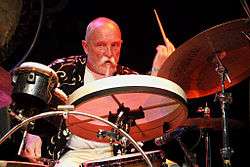
Other instruments that have regularly been incorporated into drum kits include:
- Wood block and cowbell. These are traditional in classical or culturally rich forms of music
- Tambourine, particularly mounted on the hi-hat stand above the cymbals; an ordinary tambourine can be used, or a tambourine produced specially for drum kit use
- Timbales can be used to extend the range of tom-toms, particularly when the drummer owns them for other musical settings; a traditional timbale is tuned far higher than a tom of the same diameter, so the result is not always the most ideal (see also Timbales#Non-traditional use)
- Xylophone or glockenspiel
- Tubular bells
- Gongs
- Bar chimes/orchestral chimes
- Triangles.
- Found objects, including spanners, brake drums, buckets, cardboard boxes, and jam and kerosene tins (anything ordinary that can be percussively struck to produce sounds, patterns and grooves for their setting)
See also Extended kits below.
Electronic drums

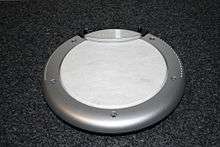
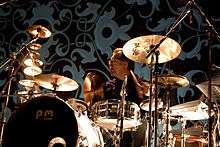
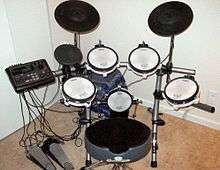
Electronic drums are used for many purposes. Some drummers use electronic drums for playing in small venues where a very low volume for the band is desired. Since electronic drums do not create any acoustic sound, with all of the drum sounds coming from a keyboard amplifier or PA system, the volume of electronic drums can be much lower than an acoustic kit. Some drummers use electronic drums as practice instruments, because they can be listened to with headphones, enabling a drummer to practice in an apartment or in the middle of the night without disturbing others. Some drummers use electronic drums to take advantage of the huge range of sounds that modern drum modules can produce, which range from sampled sounds of real drums, cymbals and percussion instruments, to electronic and synthesized sounds.
A fully electronic kit is also easier to soundcheck than acoustic drums, assuming that the electronic drum module has levels that the drummer has pre-set in her practice room; in contrast, when an acoustic kit is sound checked, most drums and cymbals need to be miked and each mike needs to be tested so its level and tone equalization can be adjusted by the sound engineer. As well, even after all the individual drum and cymbal mics are soundchecked, the engineer needs to listen to the drummer play a standard groove, to check that the balance between the instruments is right. Finally, the engineer needs to set up the monitor mix, which the drummer uses to hear her instruments and the instruments and vocals of the rest of the band.
Drummers' usage of electronic drum equipment can range from adding a single electronic pad to an acoustic kit (e.g., to have access to an instrument that might otherwise be impractical, such as a large gong), to using a mix of acoustic drums/cymbals and electronic pads, to using an acoustic kit in which the drums and cymbals have triggers, which can be used to sound electronic drums and other sounds, to having an exclusively electronic kit, which is often set up with the rubber or mesh drum pads and rubber "cymbals" in the usual drumkit locations. A fully electronic kit weighs much less and takes up less space to transport than an acoustic kit.
Electronic drum pads are the second most widely used type of MIDI performance controllers, after music keyboards.[17]:319–320 Drum controllers may be built into drum machines, they may be standalone control surfaces (e.g., rubber drum pads), or they may emulate the look and feel of acoustic percussion instruments. The pads built into drum machines are typically too small and fragile to be played with sticks, and they are played with fingers.[18]:88 Dedicated drum pads such as the Roland Octapad or the DrumKAT are playable with the hands or with sticks, and are often built in the form of a drum kit. There are also percussion controllers such as the vibraphone-style MalletKAT,[18]:88–91 and Don Buchla's Marimba Lumina.[19]
As well as providing an alternative to a conventional acoustic drum kit, electronic drums can be incorporated into an acoustic drum kit to supplement it. MIDI triggers can also be installed into acoustic drum and percussion instruments. Pads that can trigger a MIDI device can be homemade from a piezoelectric sensor and a practice pad or other piece of foam rubber.[20]
This is possible in two ways:
- Triggers are sensors that can be attached to drum kit components. In this way, an electronic drum sound will be produced when the instrument is played/struck, as well as the original sound voiced by the instrument being available, if so desired .
- Trigger pads can be mounted alongside other kit components. These pads make no significant acoustic sound themselves (if not modified to do otherwise), but are used purely to trigger the electronic sound, within the electronic source and are played with the same drum sticks as are used on other drum kit components.
In either case, an electronic control unit (sound module/"brain") with suitable sampled/modeled drum sounds, amplification equipment and monitor speakers are required. See Triggered drum kit.
A trigger pad could contain up to four independent sensors, each of them capable of sending information describing the timing and dynamic intensity of a stroke to the drum module/brain. A circular drum pad may have only one sensor for triggering, but a 2015-era cymbal-shaped rubber pad/cymbal will often contain two; one for the body and one for the bell of the cymbal, and perhaps a cymbal choke trigger, to allow drummers to produce this sound.
Trigger sensors are most commonly used to replace the acoustic drum sounds, but they can often also be used effectively with an acoustic kit to augment or supplement an instrument's sound for the needs of the session. For example, in a live performance in a difficult acoustical space, a trigger may be placed on each drum or cymbal, and used to trigger a similar sound on a drum module. These sounds are then amplified through the PA system so the audience can hear them, and they can be amplified to any level without the audio feedback or bleed problems associated with microphones in certain settings.
The sound of the drums and cymbals themselves is heard by the drummer and possibly other musicians in close proximity, but even so, the foldback (audio monitor) system is usually fed from the electronic sounds rather than the live acoustic sounds. The drums can be heavily dampened (made to resonate less or subdue the sound), and their tuning and even quality is less critical in the latter scenario. In this way, much of the atmosphere of the live performance is retained in a large venue, but without some of the problems associated with purely microphone-amplified drums.
Triggers and sensors can also be used in conjunction with conventional or built-in microphones. If some components of a kit prove more difficult to "mike" than others, triggers may be used on only the more difficult instruments, balancing out a drummer's/band's sound via the mix.
Trigger pads and drums, on the other hand, when deployed in a conventional set-up, are most commonly used to produce sounds not possible with an acoustic kit, or at least not with what is available. Any sound that can be sampled/recorded can be played when the pad is struck, by assigning the recorded sounds to specific triggers . Recordings or samples of barking dogs, sirens, breaking glass and stereo recordings of aircraft taking off and landing have all been used. Along with the more obvious electronically generated sounds there are synthesized human voices or song parts or even movie audio or digital video/pictures that (depending on device used) can also be played/triggered by electronic drums.
Virtual drums
Virtual drums are a type of audio software that simulates the sound of a drum kit. Different drum software products offer a variety of features. Those include a recording function, the ability to select from several acoustically distinctive drum kits, as well as the option to incorporate different songs into the session. Some software for the PC can turn any hard surface into a virtual drum kit using only one microphone. In the 2010s, virtual drumming software is available for mobile devices or tablet formats.
Hardware

Hardware is the name given to the metal stands that support the drums, cymbals and other percussion instruments. Generally the term also includes the hi-hat pedal and bass drum pedal or pedals, and the drum stool, but not the drum sticks.
Hardware is carried along with sticks and other accessories in the traps case, and includes:
- Cymbal stands
- Hi-hat stand
- Floor tom legs
- Tom-tom drum brackets or arms
- Snare drum stand
- Bass drum pedal or pedals
- Drum key
Particularly for large kits, many or even all of the stands may be replaced by a drum rack.
In some genres, such as jazz, drummers often set up their own drum hardware onstage. Major rock and pop band drummers on tour will often have a drum tech who knows how to set up their hardware and instruments in the drummers' desired location and layout.
Common configurations

Drum kits are traditionally categorised by the number of drums, ignoring cymbals and other instruments. Snare, tom-tom and bass drums are always counted; Other drums such as octobans may or may not be counted.[21]
The sizes of drums and cymbals given below are typical. Many drummers differ slightly or radically from them. Where no size is given, it is because there is too much variety to call a typical size.
Three-piece
A three piece drum set is the most basic set. A conventional three-piece kit consists of bass drum, 14" diameter snare drum, 12"-14" hi-hats, and a single 12" diameter hanging tom, 8"–9" in depth, and a suspended cymbal, in the range of 14"–18", both mounted on the bass drum.
Such kits were common in the 1950s and 1960s and may still be found in small acoustic dance bands. It is a common configuration for kits sold through mail order, and, with smaller size drums and cymbals, for very young drummers.
Four-piece
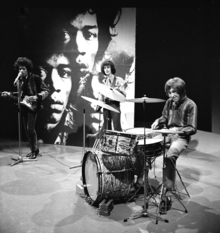
A four-piece kit extends the three-piece by one tom, either a second hanging tom mounted on the bass drum (a notable user is Chris Frantz of Talking Heads) and often displacing the cymbal, or a floor tom. Normally another cymbal is added as well, so there are separate ride and crash cymbals, either on two stands, or the ride on the bass drum to the player's right and the crash on a stand.
The standard cymbal sizes are 16" crash and 18"–20" ride, with the 20" ride most common.
Four piece with floor tom
The floor tom is most often 14" for jazz, and 16" otherwise.
Many historic bands and early rock music recordings used this configuration, notable users including Ringo Starr in the Beatles, Mitch Mitchell in the Jimi Hendrix Experience, John Barbata in the Turtles and many others.
The four-piece kit with floor tom remains popular, particularly for jazz.
Four piece with two hanging toms
If a second hanging tom is used, it is 10" diameter and 8" deep for fusion, or 13" diameter and one inch deeper than the 12" diameter tom. Otherwise, a 14" diameter hanging tom is added to the 12", both being 8" deep. In any case, both toms are most often mounted on the bass drum with the smaller of the two next to the hi-hats (on the left for a right-handed drummer).
These kits are particularly useful for smaller venues where space is limited.
Five-piece
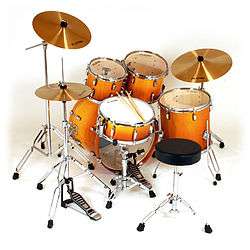
The five-piece kit is the full entry-level kit and the most common configuration. It adds a third tom, making three in all.
A fusion kit will normally add a 14" tom, either a floor tom or a hanging tom on a stand to the right of the bass drum; in either case, making the tom lineup 10", 12" and 14".
Other kits will normally have 12" and 13" hanging toms plus either a 14" hanging tom on a stand, a 14" floor tom, or a 16" floor tom. For depths, see Tom-tom drum#Modern tom-toms. In recent years, it is very popular to have 10" and 12" hanging toms, with a 16" floor tom. This configuration is often called a hybrid setup.[22]
The bass drum is most commonly 22" in diameter, but rock kits may use 24", fusion 20", jazz 18",[21] and big bands up to 26".
A second crash cymbal is common, typically an inch or two larger or smaller than the 16", with the larger of the two to the right for a right-handed drummer, but a big band may use crashes up to 20" and ride up to 24" or, very rarely, 26". A rock kit may also substitute a larger ride cymbal or larger hi-hats, typically 22" for the ride and 15" for the hats.
Most five-piece kits, at more than entry level, also have one or more effects cymbals. Adding cymbals beyond the basic ride, hi-hats and one crash configuration requires stands in addition to that of standard drum hardware packs. Because of this, many higher level kits are sold with little or even no hardware, to allow the drummer to choose the stands and also the bass drum pedal they prefer. At the other extreme, many entry level kits are sold as a five-piece kit complete with two cymbal stands, most often one straight and one boom, and some even with a standard cymbal pack, a stool and a pair of 5A drum sticks.
Modern digital kits are often offered in a five-piece kit, usually with one crash and one ride.
Small kits

If the toms are omitted completely, or the bass drum is replaced by a pedal-operated beater on the bottom skin of a floor tom and the hanging toms omitted, the result is a two-piece "cocktail" (lounge) kit. Such kits are particularly favoured in musical genres such as trad jazz, rockabilly and jump blues.
Some rockabilly kits and beginners kits for very young players omit the hi-hat stand. In rockabilly, this allows the drummer to play standing rather than seated.
Although these kits may be small with respect to the number of drums used, the drums themselves are most often normal sizes, or even larger in the case of the bass drum. Kits using smaller drums in both smaller and larger configurations are also produced for particular uses, such as boutique kits designed to reduce visual impact or space requirements, travelling kits to reduce luggage volume, and junior kits for very young players. Smaller drums also tend to be quieter, again suiting smaller venues, and many of these kits extend this with easily fitted extra muffling to the point of allowing quiet or even silent practice in a hotel room or bedroom.
Extended kits
Common extensions beyond these standard configurations include:
- Effects cymbals, particularly splash cymbals and china cymbals
- Double bass drums. Double bass drums or a double bass pedal are standard for some genres, particularly in heavy metal music
- Extra hanging or rack toms
- Extra Crash cymbals
- A crash/ride cymbal in addition to the main ride
- A second, larger or smaller floor tom
- One or more octobans or a pair of mini timbales
- A second pair of hi-hats mounted as cable hats or x-hats
- Cymbal stacks
- Individual tiger, wind or chau gongs
- Multiple ride cymbals. A sizzle cymbal, thinner and larger than the main ride, was once common as a second ride or crash/ride, even in a four-piece kit, but is now less so (jazz drummers, however, may still have two or more ride cymbals, even in a small kit)
See also other acoustic instruments above. Another versatile extension becoming increasingly common is the use of some electronic drums in a mainly conventional kit.
Less common extensions found particularly, but not exclusive to very large kits, include:
- Multiple snare drums
- Multiple bass drums beyond the double bass drum setup
- Gong drums (single headed bass drums, played with sticks or mallets)
- Sets of gongs, tuned or untuned
- Sound effects such as a thunder sheet
- One or more crotales
- Instruments "borrowed" from orchestral percussion, such as timpani
- Instruments "borrowed" from marching band percussion, such as the tuned bass drums used in the drumline
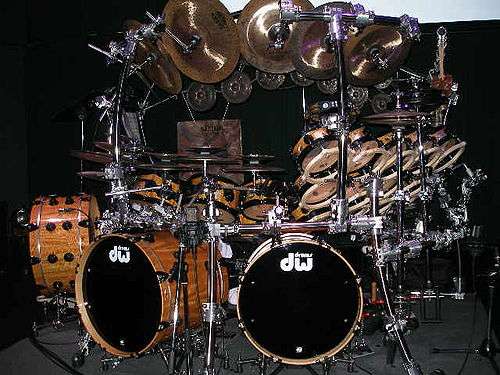
Accessories
Sticks
The most common kit-drumming sticks are wooden sticks modeled on, or in some cases identical to, those originally designed for use with the snare drum. These come in a variety of weights, conventionally expressed as a number, and tip designs, expressed as a letter following the number, with the higher numbers indicating lighter sticks. Thus, a 7A is a common jazz stick with a wooden tip, while a 7N is the same weight, with a nylon tip, and a 7B is a wooden tip but with a different tip profile (shorter and rounder than a 7A). A 5A is a common wood tipped rock stick, heavier than a 7A but with a similar profile. The numbers are most commonly odd but even numbers are used occasionally, in the range 2 (heaviest) to 9 (lightest).
The exact meanings of both numbers and letters differ from manufacturer to manufacturer, and some sticks are not described using this system at all, just being known as Jazz (typically a 7N or 8N) or Heavy Rock (typically a 4B or 5B) for example. The most common general-purpose stick is a 5A (wood tip, for snare tone) or 5N (nylon tip, for cymbal tone) or 7a for a smooth and easy tone .
Materials, other than wood (hickory, maple, oak, persimmon), used for producing sticks include aluminum (used primarily for marching band applications), acrylic (primarily for visual appeal) and graphite (most often used by "heavy hitters", playing Metal, etc.).
Other sticks commonly used are rutes, consisting of a bundle of canes, and wire or nylon drum brushes. More rarely, other beaters such as cartwheel mallets (known to kit drummers as "soft sticks") may be used. It is not uncommon for rock drummers to use the "wrong" (butt) end of a stick, and in view of this, some makers now produce tipless sticks with two "wrong" ends.
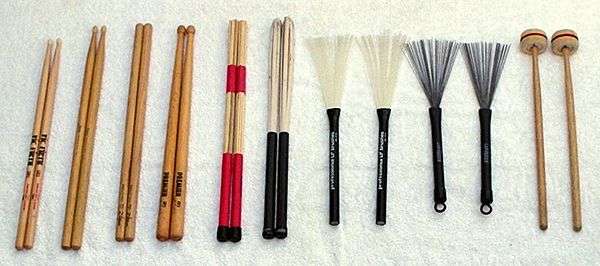
Muffles
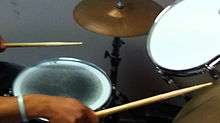
Drum muffles can reduce the ring, overtone frequencies, or volume on a snare, bass, or tom. Controlling the ring is useful in studio or live settings when unwanted frequencies can clash with other instruments in the mix. There are internal and external muffling devices which rest on the inside or outside of the drumhead, respectively. Common types of mufflers include muffling rings, gels and tape, and improvised methods, such as placing a wallet near the edge of the head.[23]
Snare drum and tom-tom Typical ways to muffle a snare or tom include placing an object on the outer edge of the drumhead. A piece of cloth, a wallet, gel, or fitted rings made of mylar are common objects. Also used are external clip-on muffles that work using the same principle. Internal mufflers that lie on the inside of the drumhead are often built into a drum, but are generally considered less effective than external muffles, as they stifle the initial tone, rather than simply reducing the sustain of it.
Bass drum Muffling the bass can be achieved with the same muffling techniques as the snare, but bass drums in a drum kit are more commonly muffled by adding pillows or another soft filling inside the drum, between the heads. Cutting a small hole in the resonant head can also produce a more muffled tone, and allows manipulation in internally placed muffling. The Evans EQ pad places a pad against the batterhead and, when struck, the pad moves off the head momentarily, then returns to rest against the head, thus reducing the sustain without choking the tone.
Silencers/mutes Another type of drum muffler is a piece of rubber that fits over the entire drumhead or cymbal. It interrupts contact between the stick and the head which dampens the sound even more. They are typically used in practice settings.
Companies with muffle products:
- Remo
- Pearl Drums
- Tama Drums
- Vic Firth
- Aquarian
- HQ Percussion
- Evans
- Cymbomute
Historical uses Muffled drums are often associated with funeral ceremonies as well, such as the funerals of John F. Kennedy and Queen Victoria.[24][25] The use of muffled drums has been written about by such poets as Henry Wadsworth Longfellow, John Mayne, and Theodore O'Hara.[26][27][28] Drums have also been used for therapy and learning purposes, such as when an experienced player will sit with a number of students and by the end of the session have all of them relaxed and playing complex rhythms.[29]
Stick holder
There are various types of stick holder accessories, including bags that can be attached to a drum and angled sheath-style stick holders, which can hold a single pair of sticks.
Sizzlers

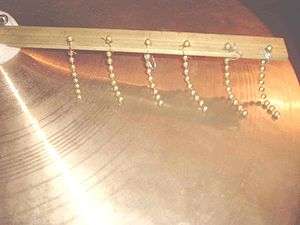
A sizzler is a metal chain or combination of chains that is hung across a cymbal, creating a distinctive metallic sound when the cymbal is struck similar to that of a sizzle cymbal. Using a sizzler is the non-destructive alternative to drilling holes in a cymbal and putting metal rivets in the holes. Another benefit of using a "sizzler" chain is that the chain can be removed and the cymbal will return to its normal sound (in contrast, a cymbal with rivets would have to have the rivets removed). Some sizzlers feature pivoting arms that allow the chains to be quickly raised from the cymbal, or lowered onto it, allowing the effect to be used for some songs and removed for others.
Cases
Three types of protective covers are common for kit drums:
- Drum bags are made from robust cloth such as cordura or from cloth-backed vinyl. They give minimal protection, but are adequate for drums transported in private vehicles to go to local gigs. They are often the only option for young working drummers who are just starting out
- Mid-price hard cases are of similar construction to suitcases, commonly made of fibre composite
- Flight cases or road cases are standard for professional touring drummers
As with all musical instruments, the best protection is afforded by a combination of a hard case with padding next to the drums or cymbals.
Microphones
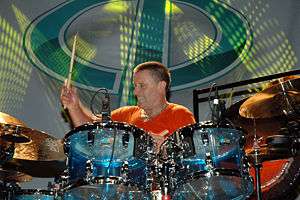
Microphones are used with drums to pick up the sound of the drums and cymbals for a sound recording and/or to pick up the sound of the drum kit so that it can be amplified through a PA system or sound reinforcement system. While most drummers use microphones and amplification in live shows in the 2010s, so that the sound engineer can adjust and balance the levels of the drums and cymbals, some bands that play in quieter genres of music and that play in small venues such as coffeehouses play acoustically, without mics or PA amplification. Small jazz groups such as jazz quartets or organ trios that are playing in a small bar will often just use acoustic drums. Of course if the same small jazz groups play on the mainstage of a big jazz festival, the drums will be mic'ed so that they can be adjusted in the sound system mix. A middle-ground approach is used by some bands that play in small venues; they do not mic every drum and cymbal, but rather mic only the instruments that the sound engineer wants to be able to control in the mix, such as the bass drum and the snare.
In "miking" a drum kit, dynamic microphones, which can handle high sound-pressure levels, are usually used to close-mic drums, which is the predominant way to mic drums for live shows. Condenser microphones are used for overheads and room mics, an approach which is more common with sound recording applications. Close miking of drums may be done using stands or by mounting the microphones on the rims of the drums, or even using microphones built into the drum itself, which eliminates the need for stands for these microphones, reducing both clutter and set-up time, as well as isolating them. In some styles of music, drummers use electronic effects on drums, such as individual noise gates that mute the attached microphone when the signal is below a threshold volume. This allows the sound engineer to use a higher overall volume for the drum kit by reducing the number of "active" mics which could produce unwanted feedback at any one time. When a drumkit is entirely miked and amplified through the sound reinforcement system, the drummer or the sound engineer can add other electronic effects to the drum sound, such as reverb or digital delay.
Some drummers arrive at the venue with their drum kit and use the mics and mic stands provided by the venue's sound engineer. Other drummers bring their all of their own mics, or selected mics (e.g., a good quality bass drum mic and a good mic for the snare) to ensure that they have good quality mics for each show. In bars and nightclubs, the microphones supplied by the venue can sometimes be in substandard condition, due to the heavy use they experience.
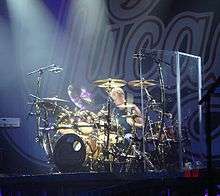
Monitors
Drummers using electronic drums, drum machines, or hybrid acoustic-electric kits (which blend traditional acoustic drums and cymbals with electronic pads) typically use a monitor speaker, keyboard amplifier or even a small PA system to hear the electronic drum sounds. Even a drummer playing entirely acoustic drums may use a monitor speaker to hear her drums, especially if she is playing in a loud rock or metal band, where there is substantial onstage volume from huge, powerful guitar stacks. Since the drum kit uses the deep bass drum, drummers are often given a large speaker cabinet with a 15" subwoofer to help them monitor their bass drum sound (along with a full-range monitor speaker to hear the rest of their kit). Some sound engineers and drummers prefer to use an electronic vibration system, colloquially known as a "butt shaker" or "throne thumper" to monitor the bass drum, because this lowers the stage volume. With a "butt shaker", the "thump" of each bass drum strike causes a vibration in the drum stool; this way the drummer feels their beat on the posterior, rather than hears it.
Gloves
Some drummers wear gloves to improve their grip on the sticks when they play. Drumming gloves often have a textured grip surface made of a synthetic or rubber material and mesh or vents on the parts of the glove not used to hold sticks, to ventilate perspiration.
Drum screen
In some styles or settings, such as country music clubs or churches, small venues, or when a live recording is being made, the drummer may use a perspex or plexiglas drum screen (also known as a drum shield) to dampen the onstage volume of the drums. A screen that completely surrounds the drum kit is known as a drum booth. In live sound applications, drum shields are used so that the audio engineer can have more control over the volume of drums that the audience hears through the PA system mix and/or to reduce the overall volume of the drums, as a way to reduce the overall volume of the band in the venue.
Carpets
Drummers often bring a carpet, mats or rugs to venues to prevent the bass drum and hi-hat stand from "crawling" (moving away) on a slippery surface from the drum head striking the bass drum. The carpet also reduces short reverberation (which is generally but not always an advantage), and helps to prevent damage to the flooring or floor coverings. In shows where multiple drummers will bring their kits onstage over the night, it is common for drummers to mark the location of their stands and pedals with tape, to allow for quicker positioning of a kits in a drummer's accustomed position. Bass drums and hi-hat stands commonly have retractable spikes to help them to grip surfaces such as carpet, or stay stationary (on hard surfaces) with rubber feet.

Practice equipment
Drummers use a variety of accessories when practicing. Metronomes and beat counters are used to develop a sense of a steady pulse. Drum muffling pads may be used to lessen the volume of drums during practicing. A practice pad, held on the lap, on a leg, or mounted on a stand, is used for near-silent practice with drumsticks. A set of practice pads mounted to simulate an entire drum kit is known as a practice kit. In the 2010s, these have largely been superseded by electronic drums, which can be listened to with headphones for quiet practice and kits with non-sounding mesh heads.

Tuning equipment
Drummers use a drum key for tuning their drums and adjusting some drum hardware. Besides the basic type of drum key (a T-handled wrench) there are various tuning wrenches and tools. Basic drum keys are divided in three types which allows tuning of three types of tuning screws on drums: square (most used), slotted and hexagonal. Ratchet-type wrenches allow high-tension drums to be tuned easily. Spin keys (utilizing a ball joint) allow rapid head changing. Torque-wrench type keys are available, graphically revealing the torque at each lug. Also, tension gauges, which are set on the head, aid in consistent tuning. Drummers can tune drums "by ear" or, in the 2010s, use a digital drum tuner, which "measures tympanic pressure" on the drumhead to provide accurate tuning.[30]


Playing
Grooves
Kit drumming, whether playing accompaniment of voices and other instruments or doing a drum solo, consists of two elements:
- A groove which sets the basic timefeel and provides a rhythmic framework for the song (examples include a back beat or shuffle).
- Drum fills and other ornaments and variations which provide variety and add interest to the drum sound. Fills could include a sting at the end of a musical section or act as a drum showpiece.
Fills
A fill is a departure from the repetitive rhythm pattern in a song. A drum fill is used to "fill in" the space between the end of one verse and the beginning of another verse or chorus. Fills vary from a simple few strokes on a tom or snare, to a distinctive rhythm played on the hi-hat, to sequences several bars long that are short virtuosic drum solos. As well as adding interest and variation to the music, fills serve an important function in preparing and indicating significant changes of sections in songs and linking sections. A vocal cue is a short drum fill that introduces a vocal entry. A fill ending with a cymbal crash on beat one is often used to lead into a chorus or verse.
Drum solos
A drum solo is an instrumental section that highlights the virtuosity, skill and musical creativity of the drummer. While other instrument solos such as guitar solos are typically accompanied by the other rhythm section instruments (e.g., bass guitar and electric guitar), for most drum solos, all the other band members stop playing so that all of the audience's focus will be on the drummer. In some drum solos, the other rhythm section instrumentalists may play "punches" at certain points–sudden, loud chords of a short duration. Drum solos are common in jazz, but they are also used in a number of rock genres, such as heavy metal and progressive rock. During drum solos, drummers have a great deal of creative freedom, and drummers often use the entire drum kit. In live concerts, drummers may be given long drum solos, even in genres where drum solos are rare on singles.
Grips

Most drummers hold the drumsticks in one of two types of grip:
- The traditional grip, originally developed for playing the military side drum, most commonly with an overhand grip for the right hand and an underhand for the left. It arose from the need to clear the counter-hoop (rim) of an angled marching drum (due to the single-point attachment of the drum sling).
- The matched grip, in which the sticks are held in similar (but mirror image) fashion.
Within these two types, there is still considerable variation, and even disagreements as to exactly how the stick is held in a particular method. For example, Jim Chapin, an early and influential exponent of the Moeller method, asserts that the technique does not rely on rebound,[31] while Dave Weckl asserts that it does rely on rebound.[32]

Notation and improvisation
Drum kit music is either written down in music notation (called "drum parts"), learned and played "by ear", improvised or some combination of some or all three of these methods. Professional session musician drummers and Big Band jazz drummers are often required to read drum parts. Drum parts are most commonly written on a standard five-line staff. In 2016, a special percussion clef is used, while previously the bass clef was used. However, even if the bass or no clef is used, each line and space is assigned an instrument of the kit, rather than to a pitch. In jazz, traditional music, folk music, rock music and pop music, drummers are expected to be able to learn songs by ear (from a recording or from another musician who is playing or singing the song) and improvise. The degree of improvisation differs in different styles. Jazz and jazz fusion drummers may have lengthy improvised solos in every song. In rock music and blues, there are also drum solos in some songs, although they tend to be shorter than those in jazz. Drummers in all popular music and traditional music styles are expected to be able to improvise accompaniment parts to songs, once they are told the genre or style (e.g., shuffle, ballad, slow blues, etc.).

| Audio samples | ||
|---|---|---|
| Component | Content | Audio (Vorbis: click the arrow to play) |
| Snare | Unmuffled snare drum | |
| Muffled snare drum | | |
| Rim click (knock) on a snare | | |
| Bass drum | Muffled bass drum | |
| Toms | 8-inch (20 cm) rack tom | |
| 12-inch (30 cm) rack tom | | |
| Floor tom | | |
| Hi-hat | Closed hi-hat | |
| Open hi-hat | | |
| Hi-hat being opened and closed by its foot pedal (chick) | | |
| Crash | Crash cymbal | |
| Ride | Hit on the bow | |
| Hit on the bell of the cymbal | | |
| Hit on the edge | | |
| Beat | A typical rock beat on hi-hat | |
| Typical rock beat on ride cymbal | | |
See also
|
People: Styles and techniques: |
Other: |
References
- ↑ "OnMusic Dictionary". Music.vt.edu. Archived from the original on 28 September 2013. Retrieved 2014-07-28.
- ↑ Remnant, M. (1989). Musical instruments. (pp. 159–174). London: B.T. Batsford Ltd.
- ↑ "Elephant Drums". elephantdrums.co.uk. Retrieved 2010-07-18.
- ↑ "Trinity College London | Home". Trinitycollege.co.uk. Retrieved 2014-07-28.
- ↑ Peter Magadini "The Drummers Guide to Music theory",2004,published by Hal Leonard, on the 'Elements of Music' & 'Form'pp. 6–18;48–52
- ↑ Porter/Hull man/Hazel (1993). Jazz – From its Origins to the Present, p.18. ISBN 0-13-512195-7.
- 1 2 Nichols, Geoff (1997). The Drum Book: The History of the Rock Drum Kit. London: Balafon Books. pp. 8–12. ISBN 0879304766.
- ↑ (Latter quote from pages 5–6 of Jon Cohan's "Star Sets- Drum Kits of the Great Drummers", with a foreword by Bill Bruford).
- ↑ Buford, Jon Cohan ; foreword by Bill (1995). Star sets : drum kits of the great drummers. Milwaukee, WI: Hal Leonard. ISBN 0-7935-3489-5.
- ↑ Information on Dodds is found in his own contemporary journals/biography "The Baby Dodds Story" -Louisiana State University Press, 1992, and by contemporary witness- drummer Gearge Wettling, who confirms Dodds was the first drummer to also keep the now-famous broken-triplet beat that became the standard pulse/roll of what we call ride cymbal playing.
- ↑ pages 8–9, Jon Cohan's- "Star Sets"- Wording, see page nine; paragraphs 1–4. Further: see the Percussive Arts Society, 'Hall of Fame' Article, by Rick Mattingly].
- ↑ J. Cohan page 13
- 1 2 Porter/Hullman/Hazel (1993). Jazz – From its Origins to the Present, p.44. ISBN 0-13-512195-7.
- ↑ "Artist Series Attack Timbales (Dave Mackintosh)". Archived from the original on 22 January 2013.
a pair of 8” diameter timbale shells with a depth of 9” and 11” respectively... 8" x 9", 8" x 11"
- ↑ Remnant, M. (1989). Musical instruments. (pp. 159–174). London: B.T. Batsford Ltd
- ↑ "Warren 'Baby' Dodds". The Percussive Arts Society. Retrieved 21 November 2011.
Dodds' way of playing press rolls ultimately evolved into the standard jazz ride-cymbal pattern. Whereas many drummers would play very short press rolls on the backbeats, Dodds would start his rolls on the backbeats but extend each one to the following beat, providing a smoother time flow.
- ↑ Manning, Peter. Electronic and Computer Music. 1985. Oxford: Oxford University Press, 1994. Print.
- 1 2 Huber, David Miles. "The MIDI Manual". Carmel, Indiana: SAMS, 1991.
- ↑ ""Marimba Lumina Described". ''buchla.com''. n.p. n.d. Web". Buchla.com. Retrieved 2012-11-27.
- ↑ White, Paul. "DIY Drum Pads And Pedal Triggers". Sound On Sound SOS Publications. Aug 1995. Print.
- 1 2 Peckman (2007), p.31.
- ↑ Steve Weiss Music http://www.steveweissmusic.com/category/drum-sets 5/10/2012
- ↑ Archived 17 June 2013 at the Wayback Machine.
- ↑ "Funeral Of Queen Victoria – British Pathé". Britishpathe.com. 2010-07-18. Retrieved 2014-07-28.
- ↑ The Funeral of John F. Kennedy in color on YouTube
- ↑ "Longfellow's "A Psalm Of Life"". Blupete.com. Retrieved 2014-07-28.
- ↑ "1805.4 – "The Muffled Drum" | Romantic Circles". Rc.umd.edu. Retrieved 2014-07-28.
- ↑ Michael Robert Patterson. "Bivouac of the Dead – Arlington National Cemetery". Arlingtoncemetery.net. Retrieved 2014-07-28.
- ↑ Ryan , A. (n.d.). Learning to play the drum: an experiential. 43(4), 435–444.
- ↑ http://www.sweetwater.com/store/detail/DrumdialDigital
- ↑ "Jim Chapin talks about the Moeller Method". 2007-01-22. Retrieved 2014-07-28.
- ↑ "Dave Weckl – Moeller Technique". 2007-01-29. Retrieved 2014-07-28.
External links
| Look up breakable or shell in Wiktionary, the free dictionary. |